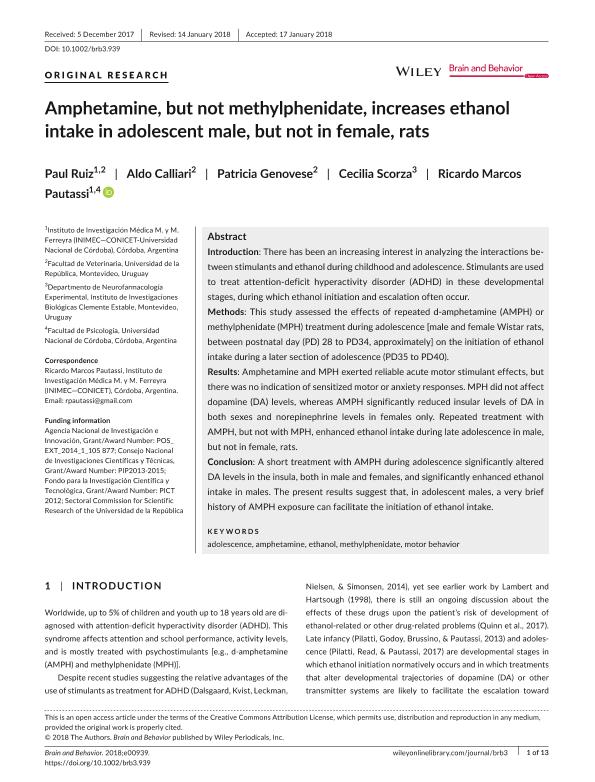Artículo
Amphetamine, but not methylphenidate, increases ethanol intake in adolescent male, but not in female, rats
Fecha de publicación:
04/2018
Editorial:
John Wiley & Sons Ltd
Revista:
Brain and Behavior
ISSN:
2162-3279
Idioma:
Inglés
Tipo de recurso:
Artículo publicado
Clasificación temática:
Resumen
Introduction: There has been an increasing interest in analyzing the interactions between stimulants and ethanol during childhood and adolescence. Stimulants are used to treat attention-deficit hyperactivity disorder (ADHD) in these developmental stages, during which ethanol initiation and escalation often occur. Methods: This study assessed the effects of repeated d-amphetamine (AMPH) or methylphenidate (MPH) treatment during adolescence [male and female Wistar rats, between postnatal day (PD) 28 to PD34, approximately] on the initiation of ethanol intake during a later section of adolescence (PD35 to PD40). Results: Amphetamine and MPH exerted reliable acute motor stimulant effects, but there was no indication of sensitized motor or anxiety responses. MPH did not affect dopamine (DA) levels, whereas AMPH significantly reduced insular levels of DA in both sexes and norepinephrine levels in females only. Repeated treatment with AMPH, but not with MPH, enhanced ethanol intake during late adolescence in male, but not in female, rats. Conclusion: A short treatment with AMPH during adolescence significantly altered DA levels in the insula, both in male and females, and significantly enhanced ethanol intake in males. The present results suggest that, in adolescent males, a very brief history of AMPH exposure can facilitate the initiation of ethanol intake.
Palabras clave:
ADOLESCENCE
,
AMPHETAMINE
,
ETHANOL
,
METHYLPHENIDATE
,
MOTOR BEHAVIOR
Archivos asociados
Licencia
Identificadores
Colecciones
Articulos(INIMEC - CONICET)
Articulos de INSTITUTO DE INV. MEDICAS MERCEDES Y MARTIN FERREYRA
Articulos de INSTITUTO DE INV. MEDICAS MERCEDES Y MARTIN FERREYRA
Citación
Ruiz, Paul; Calliari, Aldo; Genovese, Patricia; Scorza, Cecilia; Pautassi, Ricardo Marcos; Amphetamine, but not methylphenidate, increases ethanol intake in adolescent male, but not in female, rats; John Wiley & Sons Ltd; Brain and Behavior; 8; 4; 4-2018; 1-13
Compartir
Altmétricas




